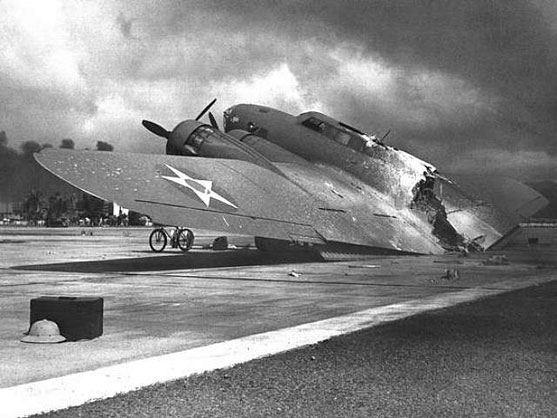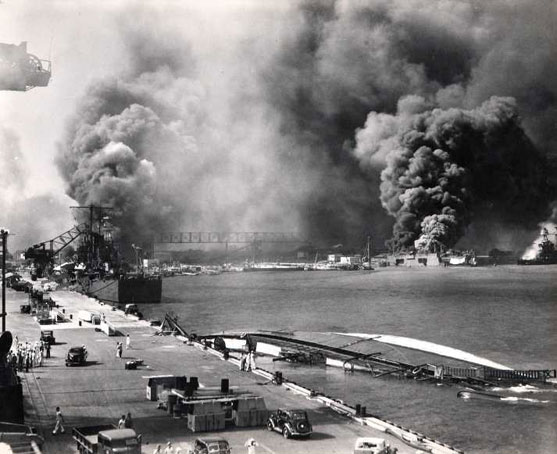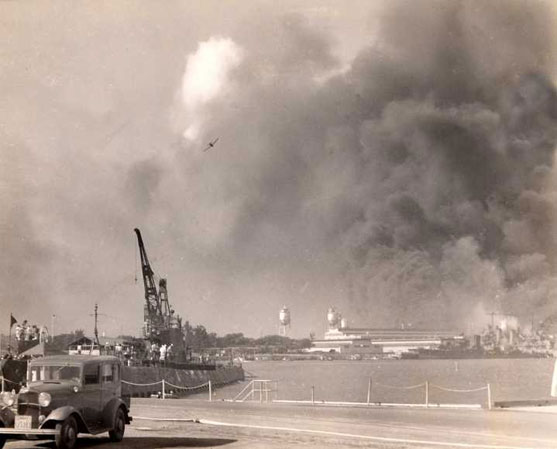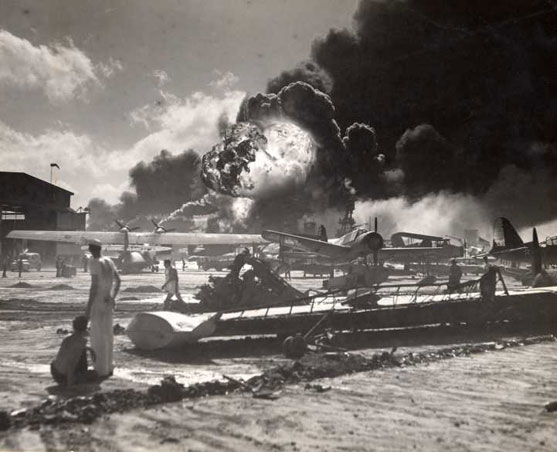| Countdown
to Pearl Harbor, Part 2 of 2
By David Lippman
August 2015
Japan's first act of aggression on 6
December 1941 is not the bombing of Pearl Harbor,
but the laying of mines off the coast of
Malaya to cover the invasion. Shortly after
3 a.m. local time, Japanese infantrymen of
the Imperial Guards Division come ashore
in Malaya, and run into stiff machine-gun
fire from British and Indian troops of the
8th Indian Brigade.
Meanwhile, at 9 a.m. in Washington, the
last part of the 14-part message arrives.
The missing piece does not mention the attack,
it merely says negotiations have come to
a standstill and must be ended. Another message
follows: the 14-part telegram must be delivered
to U.S. Secretary of State Cordell Hull by
1 p.m. Washington time, 7:30 a.m. in Hawaii.
The Japanese Embassy staff have enormous
difficulty decoding the message and translating
it into English. They do not know it must
be delivered at 1 p.m. or why. Their typist,
Katsuzo Okaumura, a junior diplomat, is a
two-fingered typist at best, and makes numerous
mistakes. Convinced his typing will lose
him face, he wastes time re-typing the entire
message.
Lt. Cdr. Alvin Kramer and Army Col. Rufus
Bratton spend a hectic morning trying to
alert someone in authority. Kramer fails,
but Bratton finally locates Chief of Staff
Gen. George C. Marshall, who determines that
the Japanese mean to attack. He sends out
an alert message to all Army commands, urging
it be passed on to the Navy as well. But
atmospherics prevent it from reaching Hawaii.
Marshall orders the message sent as a telegram.
While this is going on, Vice Adm. Chuichi
Nagumo hoists a battle flag on his carrier Akagi's signal block, the same one Adm. Heihachiro
Togo flew at Tsushima in 1905. Shortly after
that, his six carriers hurl 366 planes in
two waves at Pearl Harbor.
The lead wave, led by Cdr. Mitsuo Fuchida,
is guided in by KGMB radio, still playing
Hawaiian songs.
As the bombers roar in, the Americans have
more chances to be alerted. The U.S. destroyer Ward, under Cdr. William Outerbridge, spots
and sinks one of the midget submarines with
depth charges. But her captain's report is
dismissed by his superiors. After all, this
is Outerbridge's first patrol on his first
command.
Army radar picks up Fuchida's incoming planes.
But the fighter controller on duty, hearing
the report, says, "Well, don't worry
about it," figuring it is the incoming
B-17s. The radar crews shut down their machine
and go to breakfast.
Meanwhile, Marshall's warning arrives in
Honolulu. It's not marked "urgent," so
messenger Tadao Fuchikami rolls out on his
Indian Scout motorcycle to deliver the telegram
on his normal rounds.
At 7:50 a.m., Fuchida's lead Val dive bomber
swoops in on Pearl Harbor to find the defenses
unmanned, no AA fire or fighter patrols. "We've
made it!" he says, and sends the famous "Tora,
Tora, Tora," message, which is heard
on Akagi and in Japan. His planes roar in
on their attack courses, amazing American
sailors and Marines, who are busy preparing
for 8:00 a.m. morning colors. At 7:53, the
first bomb falls at the foot of the seaplane
ramp at Pearl Harbor. In Washington, the
Japanese are still typing up their message
for Cordell Hull.
At Pearl Harbor, Oree Miller is reading
letters from home in his office aboard USS Arizona. On USS Nevada, Lt. Joe Taussig,
the officer of the deck, is wondering which
size American flag to fly. On Arizona, SA
Carl Christiansen waits with his brother,
SN E.L. Christiansen, to go on liberty. E.L.
remembers that he's left something behind,
and goes below to find it. On USS Oklahoma,
QM1 H.S. Kennedy, father of NASU's last CO,
is standing by his rack after returning from
his morning shower. On USS Maryland, SK3
Felder Crawford is reading the Sunday funnies,
in which Navy Bob Steele deflects an unknown
air attack on his destroyer. SN Leslie Vernon
Short is addressing Christmas cards in the
battleship's foretop. Pharmacist's Mate William
Lynch, aboard California, hears a shipmate
call: "The Russians must have a carrier
visiting us. Here come some planes with the
red balls showing clearly." In Ford
Island's CPO family housing, Chief Albert
Molter does some housework. On the north
side of the harbor, 14-year-old Don Morton
finds the fish are biting. At the front gate,
the Marine guard stands tall as local photographer
Tai Sing Loe readies his camera.
The Japanese swing in simultaneously from
three directions, grooving torpedoes up the
harbor. They sink five battleships in 20
minutes. Arizona meets her fate when a bomb
hits her magazine, killing 1,177 sailors,
including Rear Adm. Isaac Kidd and E.L. Christiansen.
The force of the blast shakes Mitsuo Fuchida's
plane overhead, and hurls Radioman Glenn
Lane clean off the battleship's quarterdeck.
Oklahoma takes 12 torpedoes and capsizes,
trapping 125 men. Only 32 are ultimately
pulled free. California and West
Virginia are torn apart by bombs and torpedoes,
and sunk. After a gallant effort to break
out, Nevada is forced to ground herself on
Barber's Point. 188 American aircraft, lined
up in the center of their runways to guard
against sabotage, are destroyed on the ground.

'The War is On'
The immediate American reaction is shock,
horror, and disbelief. Army officers at Hickam
Air Base think the Marines are doing "realistic
maneuvers" against the Navy. A Marine
at MCAS Ewa yells, "Some Army pilot
has gone nuts, he's diving on HQ and shooting!" A
Navy officer shouts about another Army "SNAFU." But
the Americans soon get the picture. A chief
on the cruiser Honolulu tells his men, "The war
is on, the Japs are here!" One of his
sailors, charging up the ladder, mutters, "I
didn't even know they were sore at us."
There are numerous examples of valor on
both sides. One Japanese pilot flies his
damaged plane into the side of the seaplane
tender Curtiss, becoming the war's first
Kamikaze. The tender survives to sail on
Operation Deep Freeze II in 1956. Two midget
submarines penetrate the harbor, giving destroyer
crews a scare, but doing no damage before
they are rammed and sunk.
American valor is enormous. Sailors, marines,
airmen, and soldiers show no signs of panic,
calmly manning their stations. Capt. Mervyn
Bannion fights his battleship West
Virginia until well after he is mortally wounded.
Steward Dorie Miller, an African-American,
mans a machine gun and knocks down an enemy
plane, even though he was never trained to
use the weapon. Ensign Nathan Asher, a Jew,
senior officer on the destroyer USS Blue,
conns his ship out of the harbor. Lts. Robert
Taylor and Charles Welch get their antique
P-40 fighters in the air and shoot down four
enemy planes.
Chaplain Howell Forgy tells his men on USS Honolulu that
services are cancelled, but to "praise
the Lord and pass the ammunition." AOC
John Finn, lying in bed when the raid begins,
runs out to the Kaneohe Naval Air Station
flightline, sets up a machine gun, and opens
up on enemy planes. "Although painfully
wounded many times, he continued to man his
gun and return the enemy's fire vigorously,
and with telling effect through the enemy
strafing and bombing attacks, and with complete
disregard for his own personal safety," reads
his Congressional Medal of Honor citation.

On Maryland,
Leslie Vernon Short does a double-take when
he sees the Japanese planes, and opens fire
with the ready .50-caliber machine gun, helping
to save his ship. On Arizona,
Oree Weller races to his battlestation, a
searchlight tower on the mainmast, reaching
it just before the ship's magazines explode.
The noise is deafening, the vibration like
an earthquake. Weller calmly disconnects
and stows his sound-powered phone before
climbing down the mainmast, and swimming
through oil-covered water to a rescue launch.
SN Don Stratton is burned over 60 percent
of his body, and has to climb hand over hand
to the repair ship USS Vestal, moored alongside.
On Oklahoma, H.S. Kennedy and his shipmates
are trapped by rushing water. At the Navy
Hospital, LT Harry Walker, the cruiser New Orleans'
doctor, hobbling on a cast-wrapped leg, stays
on his feet for six hours, tending the wounded.
RMC Thomas Reeves manhandles ammunition in
a smoky passageway on California until he
falls unconscious and dies. MM2 Robert Scott
stays at his post, feeding air to the five-inch
guns as water fills his compartment, and
dies at his post.
On Maryland, CAPT W.R. Carter, Chief of
Staff for BATDIV Three, tells CDR W.F. Fitzgerald, "We
can't do much good up here. Let's go down
to the guns and give them a hand." The
two officers then help man AA batteries.
Yard worker Harry Danner drops his boring
bars to man a gun crew.
On the 110-foot garbage scow YG-17, BMC
L.M. Jansen trains his craft's sole fire
hose on the blazing West
Virginia.
Some folks cling to routine. At Wheeler
Field, an ordnance sergeant refuses to issue
weapons without written authorization. Lieutenant
Robert Overstreet bellows, "Hell, man,
this is war," and the noncom gives in.
Shipyard worker Ed Sheehan, urgently summoned
to the Shipfitter's Shop, stops to punch
the time clock before going to 1010 dock
to burn holes in the capsized minelayer Oglala.
Ensign Bill Ingram, who swims from Oklahoma to Maryland to man a flak gun, is rebuked
by Maryland's officer of the deck for failing
to wear his cover at his battle station.
On West Virginia, Marine Corps Field Musician
Dick Fiske blows "General Quarters" into
the loudspeaker. On USS Maryland, the bugler
tries to do the same, but the officer of
the deck, finding the bugle too make-believe,
tosses the trumpet into the harbor and yells
into the 1MC instead. A Nevada bandsman,
manning his AA gun, puts his trumpet to even
worse use: he loads it accidentally into
the gun and shoots it at the Japanese. At
Schofield Barracks, Bugler Frank Gobeo can't
even remember the call for "Stand to," so
he blows "Pay Call," instead, which
brings the men hurtling out of the barracks.
On Nevada, a bomb blast costs ENS Joe Taussig
his leg, but he determinedly stays at his
post as officer of the deck. American AA
shells, improperly fused, whistle off towards
downtown Honolulu and hit flyweight boxer
Toy Tamenahaha, who loses both his legs.
Ashore, American naval officers can only
stand and watch helplessly, among them officers
from the blasted Arizona and Adm. Husband
E. Kimmel, CINCPAC.
Some ships make a dash for it—most
notably Nevada,
which is forced to beach herself—but
others make it to sea during or after the
attack, among them the cruiser Phoenix, which
will survive World War II to be sold to Argentina,
becoming the General Belgrano. She is ultimately
sunk by the British nuclear-powered submarine
HMS Conqueror in
1982. USS Honolulu gets out after her deck
crew jettisons her captain's beloved hand-crafted
main brow, hurling it on the dock with a
splintering crash.

Around 9:45 a.m., the Japanese withdraw.
They leave behind battleships that are broken,
crippled wrecks, spouting orange flame and
black smoke. Arizona, her superstructure
tilted crazily, is covered with oily clouds.
At Kaneohe Naval Air Station, AOC John Finn
recalls, "After the last plane passed
over, there was absolute silence, other than
planes crackling and burning."
When the Japanese aircraft return to their
carriers, they expect to be refueled and
re-armed for a second attack, to eliminate
Pearl Harbor's drydocks and fuel tanks. But
VADM Chuichi Nagumo says, "We may conclude
that the anticipated results have been achieved." He
fears counterattack by American submarines
and carriers. He won't press his luck. He
orders his fleet to withdraw.
While Nagumo makes up his mind, in Japan,
Adm. Yamamoto, following the battle by radio,
whispers, "Admiral Nagumo is going to
withdraw." Minutes later, Yamamoto gets
word of Nagumo's decision.
Later that day, the carrier USS Enterprise sails into Pearl Harbor. Had the Japanese
launched a second attack, they would have
caught her. Instead, Enterprise refuels during
the night, is underway by dawn, and goes
on to an unparalleled war record.
Marshall's warning message arrives hours
after the attack begins. Army Gen. Walter
Short, reeling from the disaster, sends a
copy to his Navy opposite number, Kimmel,
then tosses the message in the garbage.

No Warning
The human toll is 2,330 Americans, including
34 pairs of brothers on Arizona alone. The
Japanese lose 29 aircraft, five midget submarines,
and 64 men. Ens. Kazuo Sakamaki, unable to
find Pearl Harbor, abandons his malfunctioning
sub, swims ashore, collapses from exhaustion
in front of National Guard Sgt. David M.
Akui, and becomes America's Prisoner of War
No. 1.
All across the Pacific the war begins with
authority. Japanese ships and planes attack
Guam, Wake, and Midway. 24,000 troops invade
Malaya. Japanese bombers smack Singapore
that night, which is fully lit. In the chaos
of war's outbreak, nobody can find the keys
to turn off the master switch. At Hong Kong,
Japanese bombers swoop down on Kai Tak Airport,
and destroy all five Royal Air Force planes
on the ground.
In Shanghai, the Anglo-American-ruled International
Settlement, surrounded by Japanese forces,
falls quickly. The British gunboat HMS Peterel,
commanded by New Zealand Lt. Steve Polkinghorn,
is scuttled. However, the U.S. gunboat USS Wake, after a stiff fight, is captured and
pressed into Japanese service. U.S. Marines
in Tientsin are swiftly arrested by Japanese
troops.
In Rastenburg, Germany, Adolf Hitler learns
of Japan's attack on Pearl Harbor. "Now
it is impossible for us to lose the war!" he
tells flunky Walter Hewel. "We now have
an ally who has never been vanquished in
3,000 years!" Hitler summons his admirals
to order them to deploy U-boats off the American
coast. The admirals and generals, however,
suggest that Hitler should not anger the
United States. The Fuhrer dismisses their
position, saying that America is only capable
of making razor blades, chewing gum, and
Hollywood starlets.
The same day, the Nazis begin their long-planned
campaign of gassing Jews to death at their
extermination camps in Poland. 700 Jews are
taken from the small Polish town of Kolo,
driven to Chelmno, and placed into special
vans, which drive off. By the time the journey
is over, 80 Jews are dead, gassed by exhaust
fumes which have been channelled back into
the van. The bodies are flung into a specially
dug pit, and the van is sent back to Chelmno.
It takes eight or nine trips to gas all the
Jews.
And, due to the outbreak of war, SS leader
Reinhard Heydrich postpones a conference
set for Berlin's Wannsee Hotel, to discuss
the "Final Solution of the Jewish Question," until
January.
In Britain, Winston Churchill is dining
with U.S. Ambassador John Winant, when he
gets the news. Churchill's butler hears it
on the radio. "We are all in the same
boat now," Churchill says.
In the United States, the news of Japan's
attack floods across the country like a shock
wave. Many football fans find out when a
Brooklyn Dodgers-New York Giants game is
broken up (as Bruiser Kanard tackles Ward
Cuff's kickoff return at the 10-yard line)
in a radio flash. Among those at the game
in the Polo Grounds is Henry Kissinger. John
F. Kennedy is at another football game in
Washington when he learns of the attack.
Richard Nixon finds out as he's leaving a
movie theater with his wife, Patricia.
Franklin D. Roosevelt finds out when he
gets the call from Navy Secretary Frank Knox,
while working on his stamp collection. Secretary
of War Henry Stimson orders troops to set
up AA guns on the White House roof, then
plunges into a series of conferences to get
the war organized.
New York Mayor Fiorello La Guardia orders
his city blacked out and warns his citizens
to stay calm, that the city might be attacked.
CBS radio reacts by cancelling a performance
of Gilbert and Sullivan's The
Mikado and
replacing it with HMS
Pinafore, "in
honor of the Royal Navy."
In Washington, a superpatriot chops down
four Japanese cherry trees in the Tidal Basin.
Long lines pile up in front of recruiting
offices. When one New Yorker finds the Army
line too long, he switches to the Navy. More
than 28,349 will enlist by year's end.
Brig. Gen. Dwight D. Eisenhower, just off
maneuvers in San Antonio, Texas, gets the
call from his boss, Gen. Walter Krueger,
and tells his wife, "I have to go to
headquarters. I don't know when I'll be back." It
will be four years.
In Norfolk, news that the U.S. is in the
war is greeted aboard USS Washington with
excitement. Some officers make jokes about
the Japanese being myopic and buck-toothed.
But Lt. Cdr. Hank Seely, gun boss, a China
veteran, tells his shipmates that he has
seen them in action around Shanghai, and "These
guys are really tough." The radio plays
the "Star Spangled Banner," and
all stand and sing the anthem. Then, without
word from the bridge, the battleship's crewmen
all go calmly to their battlestations to
check their ship's equipment.
In Japan, the war is announced as an Imperial
Rescript, by radio. All citizens are told
to face their radios in a "respectful
manner." The rescript, read in Court
Japanese by an official, blames the U.S.
and Britain for the war. The Tokyo stock
exchange soars after the message, and members
of the Imperial Rule Assistance Association
go to the Palace to celebrate and pray for
the Emperor. "100 Million Bullets of
Steel!" blares the Asahi Shimbun. "We
cannot lose!"
Italy's Ambassador to Japan issues a statement
hailing the attack, then drives over to a
shop to buy out Tokyo's last supply of English
Dunhill pipes. A Japanese writer notes that
while he feels the excitement of the attack,
he can't help noting that Japan's automotive
industry is a disaster, and the only decent
vehicles in the Japanese military are Chevrolet
and Dodge trucks captured in China. Takashi
Hiraoka, then a schoolboy, today the mayor
of Hiroshima, has a more personal reaction.
He's gleeful, because he thinks a scheduled
English language exam will be postponed.
It isn't. "I realized that life was
never simple," he says later.
At 2:30 p.m. in Washington, an hour after
the attack begins, Japanese Ambassador Saboru
Kurusu finally presents his note to Cordell
Hull, who knows of the attack. Hull does
not bother to ask the Japanese to sit. Hull
is stunned that the Japanese should attack
first and declare war later. "In all
my 50 years of public service," he tells
Kurusu, "I have never seen a document
more crowded with falsehoods and distortions—on
such a scale that I never imagined any government
on this planet was capable of uttering them." He
then orders the Japanese to leave.
In the wardroom of the Japanese battleship Nagato, the day's tally is brought to Adm.
Isoroku Yamamoto, commander-in-chief of the
Combined Fleet. He expresses approval that
the American battleships have been sunk,
but notes that the Japanese declaration of
war reached the Americans well after the
attack began, although the Emperor had insisted
on a half-hour's warning.
"I cannot imagine anything that would
infuriate the Americans more," Yamamoto
tells his officers.
Pick up Great Pacific War and attack or defend Pearl Harbor
David
H. Lippman, an award-winning journalist and
graduate of the New School for Social Research,
has written many magazine articles about World
War II. He currently works as a public
information officer for the city of Newark,
N.J. We're pleased to add his work to our Daily
Content.
|
